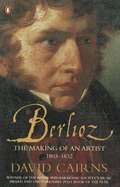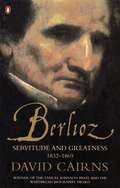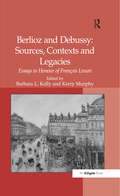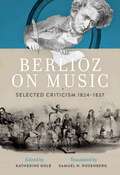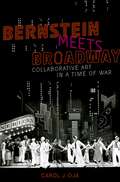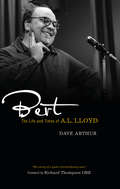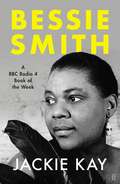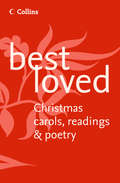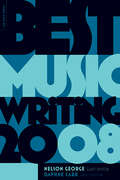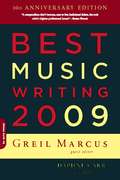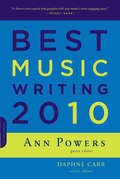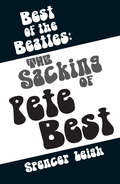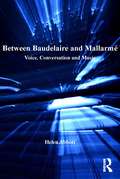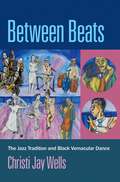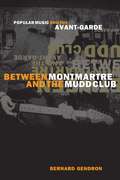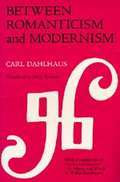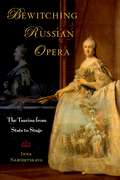- Table View
- List View
Berlioz: The Making of an Artist 1803-1832
by David CairnsNo artist's achievement connects more directly with early experience than that of Berlioz. David Cairns draws on a wealth of family papers to recreate in authentic and intimate detail the provincial milieu of Berlioz's boyhood, showing how the son of a village doctor was already transforming himself into the composer of the Fantastic Symphony. Berlioz's desperate attempts to win his father's approval for his vocation, his struggles to establish himself on the Parisian musical scene, and his passionate pursuit of love are all brought vividly to life in this first volume of David Cairn's award-winning biography.
Berlioz: Servitude and Greatness 1832-1869
by David CairnsBerlioz was one of the towering figures of Romanticism: not only was he a great and revolutionary composer, but also the finest composer of his day and an outstanding critic and writer. Yet throughout his life he struggled for money and his music was persistently reviled in his native France. With exceptional insight and sympathy, David Cairns draws together the major strands of Berlioz's life: his tempestuous marriage to the actress Harriet Smithson; the genesis of his famous works, including the Requiem, Romeo and Juliet and his crowning masterpiece The Trojans; his friendships with Mendelssohn, Liszt, Princess Wittgenstein and Wagner; and, finally, his last years haunted once again by personal tragedy. Here, as never before, is Berlioz the artist - and the man.
Berlioz and Debussy: Essays in Honour of Fran-s Lesure
by Kerry MurphyThis collection of essays by scholars of nineteenth- and early twentieth-century French music has been assembled in homage to the influential and inspirational French musicologist Fran‘s Lesure who died in 2001. Lesure's immense erudition was legendary and spanned music from the sixteenth to the twentieth century. Two French composers who were particular foci in his scholarship were Berlioz and Debussy and this collection is based on scholarship around these two composers and the sources, contexts and legacies relating to their work.
Berlioz and Debussy: Essays in Honour of Fran-s Lesure
by Kerry MurphyThis collection of essays by scholars of nineteenth- and early twentieth-century French music has been assembled in homage to the influential and inspirational French musicologist Fran‘s Lesure who died in 2001. Lesure's immense erudition was legendary and spanned music from the sixteenth to the twentieth century. Two French composers who were particular foci in his scholarship were Berlioz and Debussy and this collection is based on scholarship around these two composers and the sources, contexts and legacies relating to their work.
Berlioz on Music: Selected Criticism 1824-1837
by Katherine Kolb and Samuel N. RosenbergThe quintessential Romantic artist of his century, Hector Berlioz impressed Paganini and Liszt as "Beethoven's only heir" and dazzled the young Wagner as a composer, orchestra conductor, and critic. To Paris and all Europe, Berlioz was known as much for his writings as for his music, yet there has been no English-language anthology of his criticism available until now. Berlioz on Music plunges us into the Parisian music world during one of its most vibrant periods, the revolutionary years surrounding 1830, still resonant with memories of Napoleon and the French Revolution of only a few decades before. We follow Berlioz as he confronts the transition to a modern, commerce-driven society where music as high art has yet to find a place, using his pen to praise or scold, rouse or cajole performers, composers, managers, and the general public. The articles presented here-given in chronological order and, with a few exceptions, in their entirety-are accompanied by an introductory paragraph and notes that explain Berlioz's references to persons, musical and literary works, historical events, and more. The result is an engaging collection of Berlioz's lively prose, presented with scholarly rigor and rendered in accessible, graceful English. Scholars, lovers of Berlioz's music, history enthusiasts, and Francophiles will delight in this compelling introduction to one of the richest periods of French culture.
Berlioz on Music: Selected Criticism 1824-1837
by Katherine Kolb Samuel N. RosenbergThe quintessential Romantic artist of his century, Hector Berlioz impressed Paganini and Liszt as "Beethoven's only heir" and dazzled the young Wagner as a composer, orchestra conductor, and critic. To Paris and all Europe, Berlioz was known as much for his writings as for his music, yet there has been no English-language anthology of his criticism available until now. Berlioz on Music plunges us into the Parisian music world during one of its most vibrant periods, the revolutionary years surrounding 1830, still resonant with memories of Napoleon and the French Revolution of only a few decades before. We follow Berlioz as he confronts the transition to a modern, commerce-driven society where music as high art has yet to find a place, using his pen to praise or scold, rouse or cajole performers, composers, managers, and the general public. The articles presented here-given in chronological order and, with a few exceptions, in their entirety-are accompanied by an introductory paragraph and notes that explain Berlioz's references to persons, musical and literary works, historical events, and more. The result is an engaging collection of Berlioz's lively prose, presented with scholarly rigor and rendered in accessible, graceful English. Scholars, lovers of Berlioz's music, history enthusiasts, and Francophiles will delight in this compelling introduction to one of the richest periods of French culture.
Bernstein Meets Broadway: Collaborative Art in a Time of War (Broadway Legacies)
by Carol J. OjaWinner of the 2015 Music in American Culture Award from the American Musicological Society When Leonard Bernstein first arrived in New York City, he was an unknown artist working with other brilliant twentysomethings, notably Jerome Robbins, Betty Comden, and Adolph Green. By the end of the 1940s, these artists were world famous. Their collaborations defied artistic boundaries and subtly pushed a progressive political agenda, altering the landscape of musical theater, ballet, and nightclub comedy. In Bernstein Meets Broadway: Collaborative Art in a Time of War, award-winning author and scholar Carol J. Oja examines the early days of Bernstein's career during World War II, centering around the debut in 1944 of the Broadway musical On the Town and the ballet Fancy Free. As a composer and conductor, Bernstein experienced a meteoric rise to fame, thanks in no small part to his visionary colleagues. Together, they focused on urban contemporary life and popular culture, featuring as heroes the itinerant sailors who bore the brunt of military service. They were provocative both artistically and politically. In a time of race riots and Japanese internment camps, Bernstein and his collaborators featured African American performers and a Japanese American ballerina, staging a model of racial integration. Rather than accepting traditional distinctions between high and low art, Bernstein's music was wide-open, inspired by everything from opera and jazz to cartoons. Oja shapes a wide-ranging cultural history that captures a tumultuous moment in time. Bernstein Meets Broadway is an indispensable work for fans of Broadway musicals, dance, and American performance history.
Bernstein Meets Broadway: Collaborative Art in a Time of War (Broadway Legacies)
by Carol J. OjaWinner of the 2015 Music in American Culture Award from the American Musicological Society When Leonard Bernstein first arrived in New York City, he was an unknown artist working with other brilliant twentysomethings, notably Jerome Robbins, Betty Comden, and Adolph Green. By the end of the 1940s, these artists were world famous. Their collaborations defied artistic boundaries and subtly pushed a progressive political agenda, altering the landscape of musical theater, ballet, and nightclub comedy. In Bernstein Meets Broadway: Collaborative Art in a Time of War, award-winning author and scholar Carol J. Oja examines the early days of Bernstein's career during World War II, centering around the debut in 1944 of the Broadway musical On the Town and the ballet Fancy Free. As a composer and conductor, Bernstein experienced a meteoric rise to fame, thanks in no small part to his visionary colleagues. Together, they focused on urban contemporary life and popular culture, featuring as heroes the itinerant sailors who bore the brunt of military service. They were provocative both artistically and politically. In a time of race riots and Japanese internment camps, Bernstein and his collaborators featured African American performers and a Japanese American ballerina, staging a model of racial integration. Rather than accepting traditional distinctions between high and low art, Bernstein's music was wide-open, inspired by everything from opera and jazz to cartoons. Oja shapes a wide-ranging cultural history that captures a tumultuous moment in time. Bernstein Meets Broadway is an indispensable work for fans of Broadway musicals, dance, and American performance history.
Bert: The Life and Times of A. L. Lloyd
by Dave ArthurFolk singer and folk music collector, writer, painter, journalist, art critic, whalerman, sheep station roustabout, Marxist, and much more - this is the story of A. L. (Bert) Lloyd's extraordinary life. *BR**BR*A. L. Lloyd played a key part in the folk music revival of the 1950s and 60s, but that is only part of his story. Dave Arthur documents how Lloyd became a member of the Communist Party, forceful antifascist, trade unionist and an important part of left-wing culture from the early 1930s to his death in 1982. Following his return from Australia as a 21-year-old, self-educated agricultural labourer, he was at the heart of the most important left-wing movements and highly respected for his knowledge in various fields. *BR**BR*Dave Arthur recounts the life of a creative, passionate and life-loving Marxist, and in so doing provides a social history of a turbulent twentieth century.
Bert: The Life and Times of A. L. Lloyd
by Dave ArthurFolk singer and folk music collector, writer, painter, journalist, art critic, whalerman, sheep station roustabout, Marxist, and much more - this is the story of A. L. (Bert) Lloyd's extraordinary life. *BR**BR*A. L. Lloyd played a key part in the folk music revival of the 1950s and 60s, but that is only part of his story. Dave Arthur documents how Lloyd became a member of the Communist Party, forceful antifascist, trade unionist and an important part of left-wing culture from the early 1930s to his death in 1982. Following his return from Australia as a 21-year-old, self-educated agricultural labourer, he was at the heart of the most important left-wing movements and highly respected for his knowledge in various fields. *BR**BR*Dave Arthur recounts the life of a creative, passionate and life-loving Marxist, and in so doing provides a social history of a turbulent twentieth century.
Bessie Smith: A RADIO 4 BOOK OF THE WEEK (Outlines Ser.)
by Jackie KayA BBC RADIO 4 BOOK OF THE WEEKBessie Smith: singer, icon, pioneer.Scotland's National Poet Jackie Kay brings to life the tempestuous story of the greatest blues singer who ever lived. 'A wonderful writer on a magnificent singer.' ROBERT WYATT'The most vivid evocation of Bessie Smith I have ever read.' IAN CARR, BBC MUSIC 'Biographies don't usually bring the subject to life again. This one did. I finished the book then started it again immediately.' PEGGY SEEGER'What a life! What gulpable storytelling! Exactly the kind of writing about music we need: personal, ardent, playfully confrontational, questioning, undogmatic. A love song to a complicated idol' KATE MOLLESON'Pure joy: one trailblazing woman pays tribute to another. Jackie Kay finds the music in the short, dazzling, capricious life of Bessie Smith'HELEN LEWIS'A passionate, personal, imaginative insight into Bessie's art.' DAILY MAIL***BESSIE SMITH was born in Tennessee in 1894. Orphaned by the age of nine, she sang on street corners before becoming a big name in travelling shows. In 1923 she made her first recording for a new start-up called Columbia Records. It sold 780,000 copies and made her a star. Smith's life was notoriously difficult: she drank pints of 'bathtub gin', got into violent fist fights, spent huge sums of money and had passionate love affairs with men and women. She once single-handedly fought off a cohort of the Ku Klux Klan.As a young black girl growing up in Glasgow, Jackie Kay found in Bessie someone with whom she could identify and who she could idolise. In this remarkable book Kay mixes biography, fiction, poetry and prose to create an enthralling account of an extraordinary life.
Best Loved Christmas Carols, Readings and Poetry
by Martin ManserA collection of favourite Christmas carols, poetry and readings – a perfect Christmas gift.
Best Music Writing 2008
by Nelson George Daphne CarrThe ninth entry in the acclaimed series celebrating the best writing on every style of music, from rock to hip-hop, R&B to jazz, pop to blues, and more.Best music writing is the definitive guide to the year in music writing, an annual feast of essays, missives, and musings on every musical style by critics, novelists, and musicians themselves. Culled from publications ranging from blogs to the New Yorker, the 2008 edition captures a year in music writing as diverse and riveting as the music it illuminates.Writers who have appeared in Best Music Writing include: Greil Marcus, Sarah Vowell, Nick Tosches, Jonathan Lethem, Dave Eggers, David Rakoff, David Hadju, Lenny Kaye, The Onion, Gary Giddins, Jessica Hopper, Luc Sante, Kelefa Sanneh, David Byrne, Daphne A. Brooks, Jody Rosen, Anne Midgette, Sasha Frere-Jones, Elizabeth Méndez Berry, Alex Ross, Touré, Lynn Hirschberg, Chuck Klosterman, Elizabeth Gilbert, Jay McInerney, Elvis Costello, Susan Orlean, Mike Doughty, Lorraine Ali, and many more.
Best Music Writing 2009
by Greil MarcusBest Music Writing has faithfully collected the year's most compelling writing on music for a decade now, so it's appropriate this special edition be guest-edited by one of the best-known writers on music and popular culture, Greil Marcus, author of Lipstick Traces, Mystery Train, Like a Rolling Stone, and other groundbreaking excursions into the very fabric of music, America, and beyond.As always, Series Editor Daphne Carr has culled an impressively wide range of essays, profiles, news articles, interviews, creative non-fiction, fiction, book reviews, long-format reviews, blog posts, and journal articles on music and music culture, from rock and hip-hop to R&B and jazz to pop, blues, and more. Writers who have been published in Best Music Writing include Alex Ross, Jonathan Lethem, Ann Powers, Dave Eggers, Susan Orlean, and more.
Best Music Writing 2010
by Ann Powers Daphne CarrBest Music Writing has become one of the most eagerly awaited annuals out there. Celebrating the year in music writing by gathering a rich array of essays, missives, and musings on every style of music from rock to hip-hop to R&B to jazz to pop to blues and more, it is essential reading for anyone who loves great music and accomplished writing. Scribes of every imaginable sort-novelists, poets, journalists, musicians-are gathered to create a multi-voiced snapshot of the year in music writing that, like the music it illuminates, is every bit as thrilling as it is riveting.
Best of the Beatles: The sacking of Pete Best
by Spencer LeighWhy was Pete Best sacked from the Beatles? In this unique book, based on extensive research and interviews with those close to the events, Spencer Leigh has gathered the clues together to try and solve the greatest Beatles mystery of all. On 16 August 1962, the Beatles drummer, Pete Best, went to see their manager, Brian Epstein, in his Liverpool office. He thought that Epstein wanted to discuss future bookings with him but instead, Epstein sacked him. Pete had not seen it coming. Why did Brian Epstein do it and not the Beatles themselves? Why did they want to be rid of him? Why did they do it so callously? Pete never spoke to any of them again. Best of the Beatles: The sacking of Pete Best tells you what really happened and is essential reading for Beatles fans.
Between Air and Electricity: Microphones and Loudspeakers as Musical Instruments
by Cathy Van EckComposers and sound artists have explored for decades how to transform microphones and loudspeakers from “inaudible” technology into genuinely new musical instruments. While the sound reproduction industry had claimed perfect high fidelity already at the beginning of the twentieth century, these artists found surprising ways of use – for instance tweaking microphones, swinging loudspeakers furiously around, ditching microphones in all kinds of vessels, or strapping loudspeakers to body parts of the audience. Between air and electricity traces their quest and sets forward a new theoretical framework, providing historic background on technological and artistic development, and diagrams of concert and performance set-ups. From popular noise musician Merzbow to minimalist classic Alvin Lucier, cult instrument inventor Hugh Davies, or contemporary visual artist Lynn Pook – they all aimed to make audible what was supposed to remain silent.www.microphonesandloudspeakers.com
Between Baudelaire and Mallarmé: Voice, Conversation and Music
by Helen AbbottAs the status of poetry became less and less certain over the course of the nineteenth century, poets such as Baudelaire and Mallarmé began to explore ways to ensure that poetry would not be overtaken by music in the hierarchy of the arts. Helen Abbott examines the verse and prose poetry of these two important poets, together with their critical writings, to address how their attitudes towards the performance practice of poetry influenced the future of both poetry and music. Central to her analysis is the issue of 'voice', a term that remains elusive in spite of its broad application. Acknowledging that voice can be physical, textual and symbolic, Abbott explores the meaning of voice in terms of four categories: (1) rhetoric, specifically the rules governing the deployment of voice in poetry; (2) the human body and its effect on how voice is used in poetry; (3) exchange, that is, the way voices either interact or fail to interact; and (4) music, specifically the question of whether poetry should be sung. Abbott shows how Baudelaire and Mallarmé exploit the complexity and instability of the notion of voice to propose a new aesthetic that situates poetry between conversation and music. Voice thus becomes an important process of interaction and exchange rather than something stable or static; the implications of this for Baudelaire and Mallarmé are profoundly significant, since it maps out the possible future of poetry.
Between Baudelaire and Mallarmé: Voice, Conversation and Music
by Helen AbbottAs the status of poetry became less and less certain over the course of the nineteenth century, poets such as Baudelaire and Mallarmé began to explore ways to ensure that poetry would not be overtaken by music in the hierarchy of the arts. Helen Abbott examines the verse and prose poetry of these two important poets, together with their critical writings, to address how their attitudes towards the performance practice of poetry influenced the future of both poetry and music. Central to her analysis is the issue of 'voice', a term that remains elusive in spite of its broad application. Acknowledging that voice can be physical, textual and symbolic, Abbott explores the meaning of voice in terms of four categories: (1) rhetoric, specifically the rules governing the deployment of voice in poetry; (2) the human body and its effect on how voice is used in poetry; (3) exchange, that is, the way voices either interact or fail to interact; and (4) music, specifically the question of whether poetry should be sung. Abbott shows how Baudelaire and Mallarmé exploit the complexity and instability of the notion of voice to propose a new aesthetic that situates poetry between conversation and music. Voice thus becomes an important process of interaction and exchange rather than something stable or static; the implications of this for Baudelaire and Mallarmé are profoundly significant, since it maps out the possible future of poetry.
Between Beats: The Jazz Tradition and Black Vernacular Dance
by Christi Jay WellsBetween Beats: The Jazz Tradition and Black Vernacular Dance offers a new look at the complex intersections between jazz music and popular dance over the last hundred-plus years. Author Christi Jay Wells shows how popular entertainment and cultures of social dancing were crucial to jazz music's formation and development even as jazz music came to earn a reputation as a "legitimate" art form better suited for still, seated listening. Through the concept of choreographies of listening, the book explores amateur and professional jazz dancers' relationships with jazz music and musicians as jazz's soundscapes and choreoscapes were forged through close contact and mutual creative exchange. It also unpacks the aesthetic and political negotiations through which jazz music supposedly distanced itself from dancing bodies. Fusing little-discussed material from diverse historical and contemporary sources with the author's own years of experience as a social jazz dancer, it advances participatory dance and embodied practice as central topics of analysis in jazz studies. As it explores the fascinating history of jazz as popular dance music, it exposes how American anxieties about bodies and a broad cultural privileging of the cerebral over the corporeal have shaped efforts to "elevate" expressive forms such as jazz to elite status.
Between Beats: The Jazz Tradition and Black Vernacular Dance
by Christi Jay WellsBetween Beats: The Jazz Tradition and Black Vernacular Dance offers a new look at the complex intersections between jazz music and popular dance over the last hundred-plus years. Author Christi Jay Wells shows how popular entertainment and cultures of social dancing were crucial to jazz music's formation and development even as jazz music came to earn a reputation as a "legitimate" art form better suited for still, seated listening. Through the concept of choreographies of listening, the book explores amateur and professional jazz dancers' relationships with jazz music and musicians as jazz's soundscapes and choreoscapes were forged through close contact and mutual creative exchange. It also unpacks the aesthetic and political negotiations through which jazz music supposedly distanced itself from dancing bodies. Fusing little-discussed material from diverse historical and contemporary sources with the author's own years of experience as a social jazz dancer, it advances participatory dance and embodied practice as central topics of analysis in jazz studies. As it explores the fascinating history of jazz as popular dance music, it exposes how American anxieties about bodies and a broad cultural privileging of the cerebral over the corporeal have shaped efforts to "elevate" expressive forms such as jazz to elite status.
Between Montmartre and the Mudd Club: Popular Music and the Avant-Garde
by Bernard GendronDuring the late nineteenth and early twentieth century, popular music was considered nothing but vulgar entertainment. Today, jazz and rock music are seen as forms of art, and their practitioners are regularly accorded a status on par with the cultural and political elite. To take just one recent example, Bono, lead singer and lyricist of the rock band U2, got equal and sometimes higher billing than Pope John Paul II on their shared efforts in the Jubilee 2000 debt-relief project. When and how did popular music earn so much cultural capital? To find out, Bernard Gendron investigates five key historical moments when popular music and avant-garde art transgressed the rigid boundaries separating high and low culture to form friendly alliances. He begins at the end of the nineteenth century in Paris's Montmartre district, where cabarets showcased popular music alongside poetry readings in spaces decorated with modernist art works. Two decades later, Parisian poets and musicians "slumming" in jazz clubs assimilated jazz's aesthetics in their performances and compositions. In the bebop revolution in mid-1940s America, jazz returned the compliment by absorbing modernist devices and postures, in effect transforming itself into an avant-garde art form. Mid-1960s rock music, under the leadership of the Beatles, went from being reviled as vulgar music to being acclaimed as a cutting-edge art form. Finally, Gendron takes us to the Mudd Club in the late 1970s, where New York punk and new wave rockers were setting the aesthetic agenda for a new generation of artists. Between Montmartre and the Mudd Club should be on the shelves of anyone interested in the intersections between high and low culture, art and music, or history and aesthetics.
Between Montmartre and the Mudd Club: Popular Music and the Avant-Garde
by Bernard GendronDuring the late nineteenth and early twentieth century, popular music was considered nothing but vulgar entertainment. Today, jazz and rock music are seen as forms of art, and their practitioners are regularly accorded a status on par with the cultural and political elite. To take just one recent example, Bono, lead singer and lyricist of the rock band U2, got equal and sometimes higher billing than Pope John Paul II on their shared efforts in the Jubilee 2000 debt-relief project. When and how did popular music earn so much cultural capital? To find out, Bernard Gendron investigates five key historical moments when popular music and avant-garde art transgressed the rigid boundaries separating high and low culture to form friendly alliances. He begins at the end of the nineteenth century in Paris's Montmartre district, where cabarets showcased popular music alongside poetry readings in spaces decorated with modernist art works. Two decades later, Parisian poets and musicians "slumming" in jazz clubs assimilated jazz's aesthetics in their performances and compositions. In the bebop revolution in mid-1940s America, jazz returned the compliment by absorbing modernist devices and postures, in effect transforming itself into an avant-garde art form. Mid-1960s rock music, under the leadership of the Beatles, went from being reviled as vulgar music to being acclaimed as a cutting-edge art form. Finally, Gendron takes us to the Mudd Club in the late 1970s, where New York punk and new wave rockers were setting the aesthetic agenda for a new generation of artists. Between Montmartre and the Mudd Club should be on the shelves of anyone interested in the intersections between high and low culture, art and music, or history and aesthetics.
Between Romanticism and Modernism: Four Studies in the Music of the Later Nineteenth Century (California Studies In 19th-century Music #1)
by Carl Dahlhaus Mary WhittallCarl Dahlhaus here treats Nietzsche's youthful analysis of the contradictions in Wagner's doctrine (and, more generally, in romantic musical aesthetics); the question of periodicization in romantic and neo-romantic music; the underlying kinship between Brahms's and Wagner's responses to the central musical problems of their time; and the true significance of musical nationalism. Included in this volume is Walter Kauffman's translation of the previously unpublished fragment, "On Music and Words," by the young Nietzsche.
Bewitching Russian Opera: The Tsarina from State to Stage
by Inna NaroditskayaIn Bewitching Russian Opera: The Tsarina from State to Stage, author Inna Naroditskaya investigates the musical lives of four female monarchs who ruled Russia for most of the eighteenth century: Catherine I, Anna, Elizabeth, and Catherine the Great. Engaging with ethnomusicological, historical, and philological approaches, her study traces the tsarinas' deeply invested interest in musical drama, as each built theaters, established drama schools, commissioned operas and ballets, and themselves wrote and produced musical plays. Naroditskaya examines the creative output of the tsarinas across the contexts in which they worked and lived, revealing significant connections between their personal creative aspirations and contemporary musical-theatrical practices, and the political and state affairs conducted during their reigns. Through contemporary performance theory, she demonstrates how the opportunity for role-playing and costume-changing in performative spaces allowed individuals to cross otherwise rigid boundaries of class and gender. A close look at a series of operas and musical theater productions--from Catherine the Great's fairy tale operas to Tchaikovsky's Pique Dame--illuminates the transition of these royal women from powerful political and cultural figures during their own reigns, to a marginalized and unreal Other under the patriarchal dominance of the subsequent period. These tsarinas successfully fostered the concept of a modern nation and collective national identity, only to then have their power and influence undone in Russian cultural consciousness through the fairy-tales operas of the 19th century that positioned tsarinas as "magical" and dangerous figures rightfully displaced and conquered--by triumphant heroes on the stage, and by the new patriarchal rulers in the state. Ultimately, this book demonstrates that the theater served as an experimental space for these imperial women, in which they rehearsed, probed, and formulated gender and class roles, and performed on the musical stage political ambitions and international conquests which they would later enact on the world stage itself.
